Role of ERP in Organizations
VerifiedAdded on 2023/03/23
|21
|4449
|39
AI Summary
This document discusses the role of ERP systems in organizations and how they help manage different functions. It explores the benefits of ERP and the stages of implementation. Find study material and solved assignments on ERP at Desklib.
Contribute Materials
Your contribution can guide someone’s learning journey. Share your
documents today.
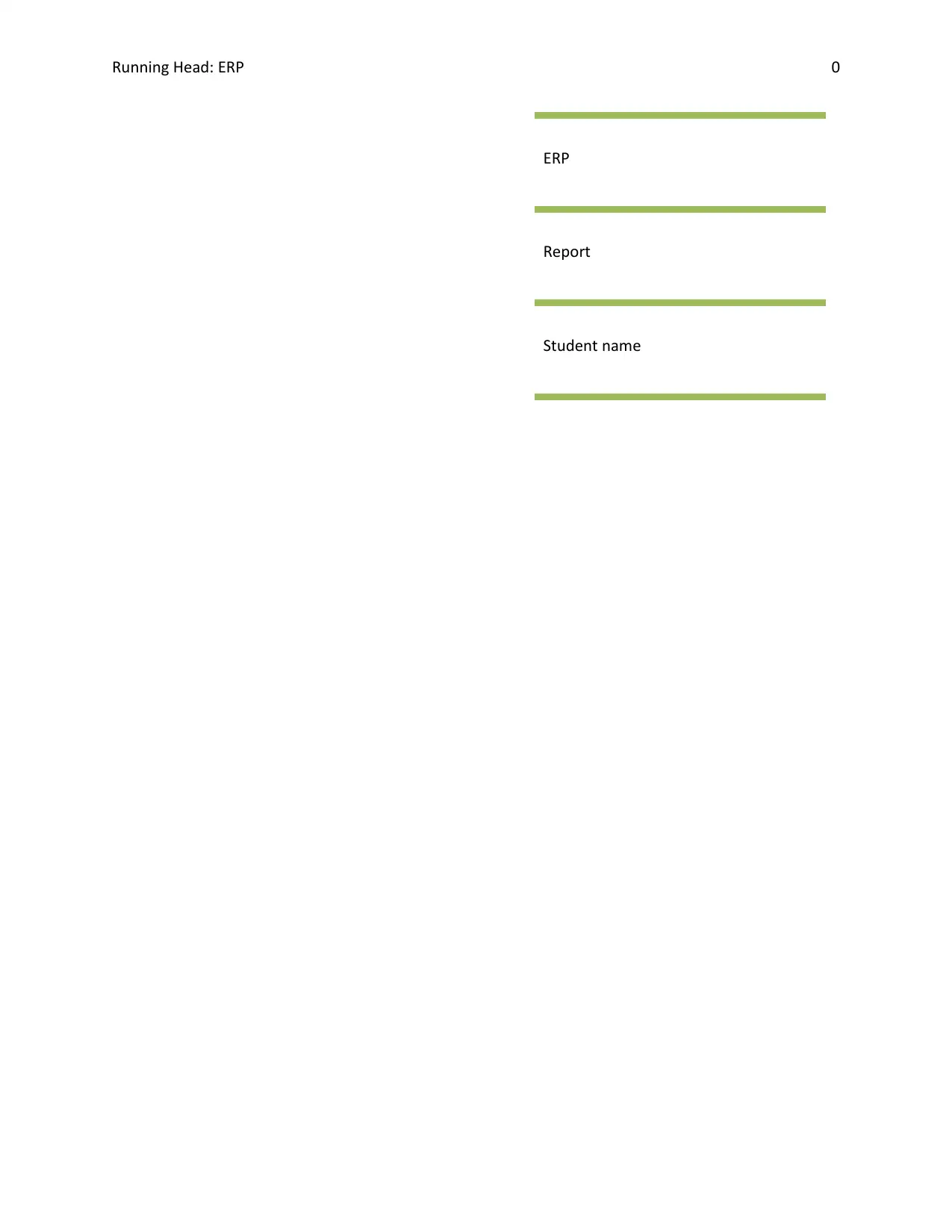
Running Head: ERP 0
ERP
Report
Student name
ERP
Report
Student name
Secure Best Marks with AI Grader
Need help grading? Try our AI Grader for instant feedback on your assignments.

ERP 1
Table of Contents
Introduction.................................................................................................................................................2
ERP system role in an organization..............................................................................................................3
An ERP solution in the Cloud:..................................................................................................................6
Cloud versions of existing ERP systems:..................................................................................................6
Bolt-on solutions of ERP systems:............................................................................................................6
Hosted ERP systems:...............................................................................................................................6
ERP implementation stages.........................................................................................................................6
Benefits of ERP............................................................................................................................................9
Barrier in successful implementation of ERP.............................................................................................10
Conclusion.................................................................................................................................................13
References.................................................................................................................................................14
Figure 1 ERP.................................................................................................................................................3
Figure 2 Reasons for implementing ERP......................................................................................................4
Figure 3Types of ERP software....................................................................................................................5
Figure 4 ERP cloud benefits.........................................................................................................................5
Figure 5 ERP in Cloud...................................................................................................................................6
Figure 6 ERP implementation process.........................................................................................................7
Figure 7 ERP implementation cycle.............................................................................................................8
Figure 8 Revenue worldwide from 2014 to 2020........................................................................................8
Figure 9 ERP modules..................................................................................................................................9
Figure 10 ERP functions.............................................................................................................................10
Figure 11 ERP testing.................................................................................................................................11
Figure 12 ERP Implementation outcome...................................................................................................12
Figure 13 Digital Business Framework 2.0.................................................................................................12
Figure 14 SAP R/4......................................................................................................................................13
Table of Contents
Introduction.................................................................................................................................................2
ERP system role in an organization..............................................................................................................3
An ERP solution in the Cloud:..................................................................................................................6
Cloud versions of existing ERP systems:..................................................................................................6
Bolt-on solutions of ERP systems:............................................................................................................6
Hosted ERP systems:...............................................................................................................................6
ERP implementation stages.........................................................................................................................6
Benefits of ERP............................................................................................................................................9
Barrier in successful implementation of ERP.............................................................................................10
Conclusion.................................................................................................................................................13
References.................................................................................................................................................14
Figure 1 ERP.................................................................................................................................................3
Figure 2 Reasons for implementing ERP......................................................................................................4
Figure 3Types of ERP software....................................................................................................................5
Figure 4 ERP cloud benefits.........................................................................................................................5
Figure 5 ERP in Cloud...................................................................................................................................6
Figure 6 ERP implementation process.........................................................................................................7
Figure 7 ERP implementation cycle.............................................................................................................8
Figure 8 Revenue worldwide from 2014 to 2020........................................................................................8
Figure 9 ERP modules..................................................................................................................................9
Figure 10 ERP functions.............................................................................................................................10
Figure 11 ERP testing.................................................................................................................................11
Figure 12 ERP Implementation outcome...................................................................................................12
Figure 13 Digital Business Framework 2.0.................................................................................................12
Figure 14 SAP R/4......................................................................................................................................13

ERP 2
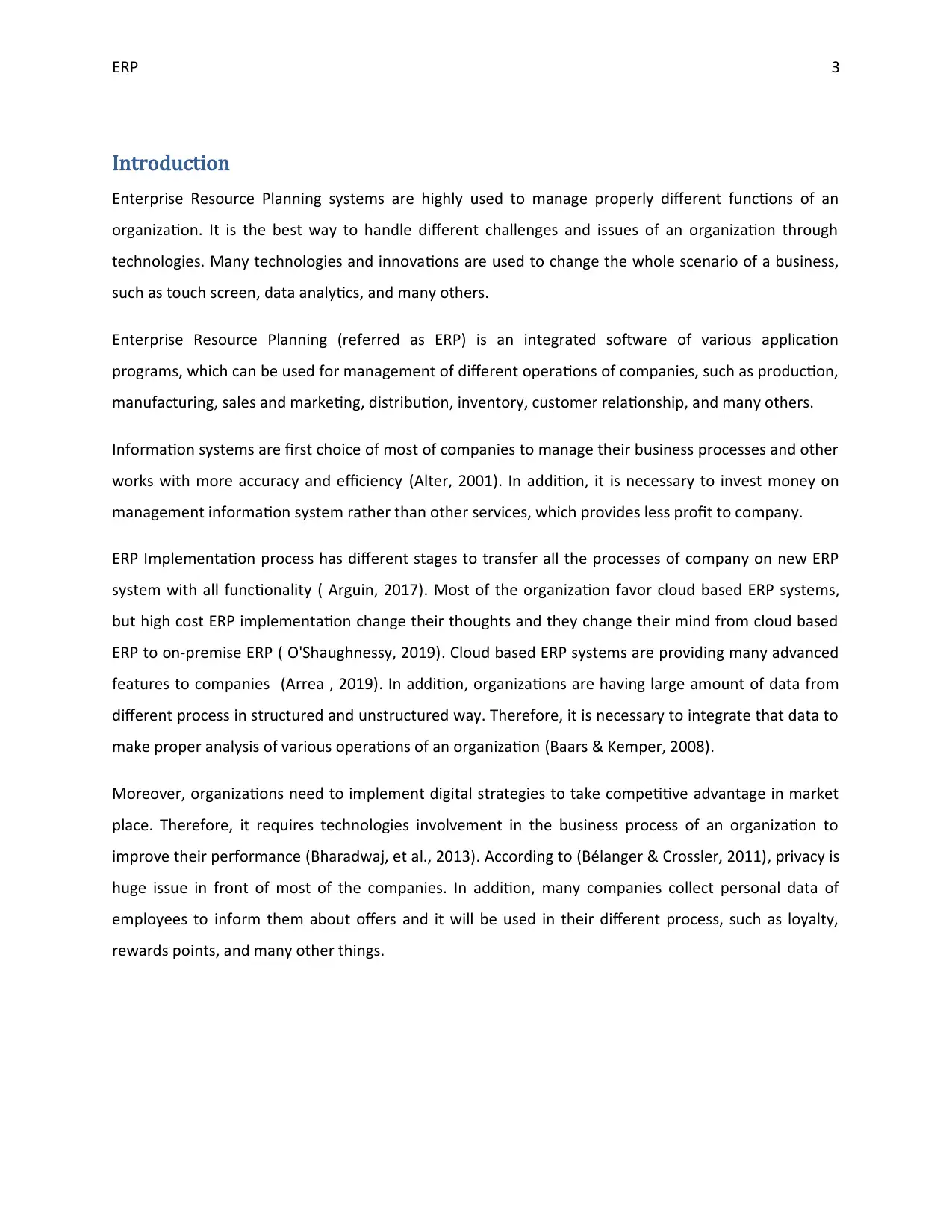
ERP 3
Introduction
Enterprise Resource Planning systems are highly used to manage properly different functions of an
organization. It is the best way to handle different challenges and issues of an organization through
technologies. Many technologies and innovations are used to change the whole scenario of a business,
such as touch screen, data analytics, and many others.
Enterprise Resource Planning (referred as ERP) is an integrated software of various application
programs, which can be used for management of different operations of companies, such as production,
manufacturing, sales and marketing, distribution, inventory, customer relationship, and many others.
Information systems are first choice of most of companies to manage their business processes and other
works with more accuracy and efficiency (Alter, 2001). In addition, it is necessary to invest money on
management information system rather than other services, which provides less profit to company.
ERP Implementation process has different stages to transfer all the processes of company on new ERP
system with all functionality ( Arguin, 2017). Most of the organization favor cloud based ERP systems,
but high cost ERP implementation change their thoughts and they change their mind from cloud based
ERP to on-premise ERP ( O'Shaughnessy, 2019). Cloud based ERP systems are providing many advanced
features to companies (Arrea , 2019). In addition, organizations are having large amount of data from
different process in structured and unstructured way. Therefore, it is necessary to integrate that data to
make proper analysis of various operations of an organization (Baars & Kemper, 2008).
Moreover, organizations need to implement digital strategies to take competitive advantage in market
place. Therefore, it requires technologies involvement in the business process of an organization to
improve their performance (Bharadwaj, et al., 2013). According to (Bélanger & Crossler, 2011), privacy is
huge issue in front of most of the companies. In addition, many companies collect personal data of
employees to inform them about offers and it will be used in their different process, such as loyalty,
rewards points, and many other things.
Introduction
Enterprise Resource Planning systems are highly used to manage properly different functions of an
organization. It is the best way to handle different challenges and issues of an organization through
technologies. Many technologies and innovations are used to change the whole scenario of a business,
such as touch screen, data analytics, and many others.
Enterprise Resource Planning (referred as ERP) is an integrated software of various application
programs, which can be used for management of different operations of companies, such as production,
manufacturing, sales and marketing, distribution, inventory, customer relationship, and many others.
Information systems are first choice of most of companies to manage their business processes and other
works with more accuracy and efficiency (Alter, 2001). In addition, it is necessary to invest money on
management information system rather than other services, which provides less profit to company.
ERP Implementation process has different stages to transfer all the processes of company on new ERP
system with all functionality ( Arguin, 2017). Most of the organization favor cloud based ERP systems,
but high cost ERP implementation change their thoughts and they change their mind from cloud based
ERP to on-premise ERP ( O'Shaughnessy, 2019). Cloud based ERP systems are providing many advanced
features to companies (Arrea , 2019). In addition, organizations are having large amount of data from
different process in structured and unstructured way. Therefore, it is necessary to integrate that data to
make proper analysis of various operations of an organization (Baars & Kemper, 2008).
Moreover, organizations need to implement digital strategies to take competitive advantage in market
place. Therefore, it requires technologies involvement in the business process of an organization to
improve their performance (Bharadwaj, et al., 2013). According to (Bélanger & Crossler, 2011), privacy is
huge issue in front of most of the companies. In addition, many companies collect personal data of
employees to inform them about offers and it will be used in their different process, such as loyalty,
rewards points, and many other things.
Secure Best Marks with AI Grader
Need help grading? Try our AI Grader for instant feedback on your assignments.
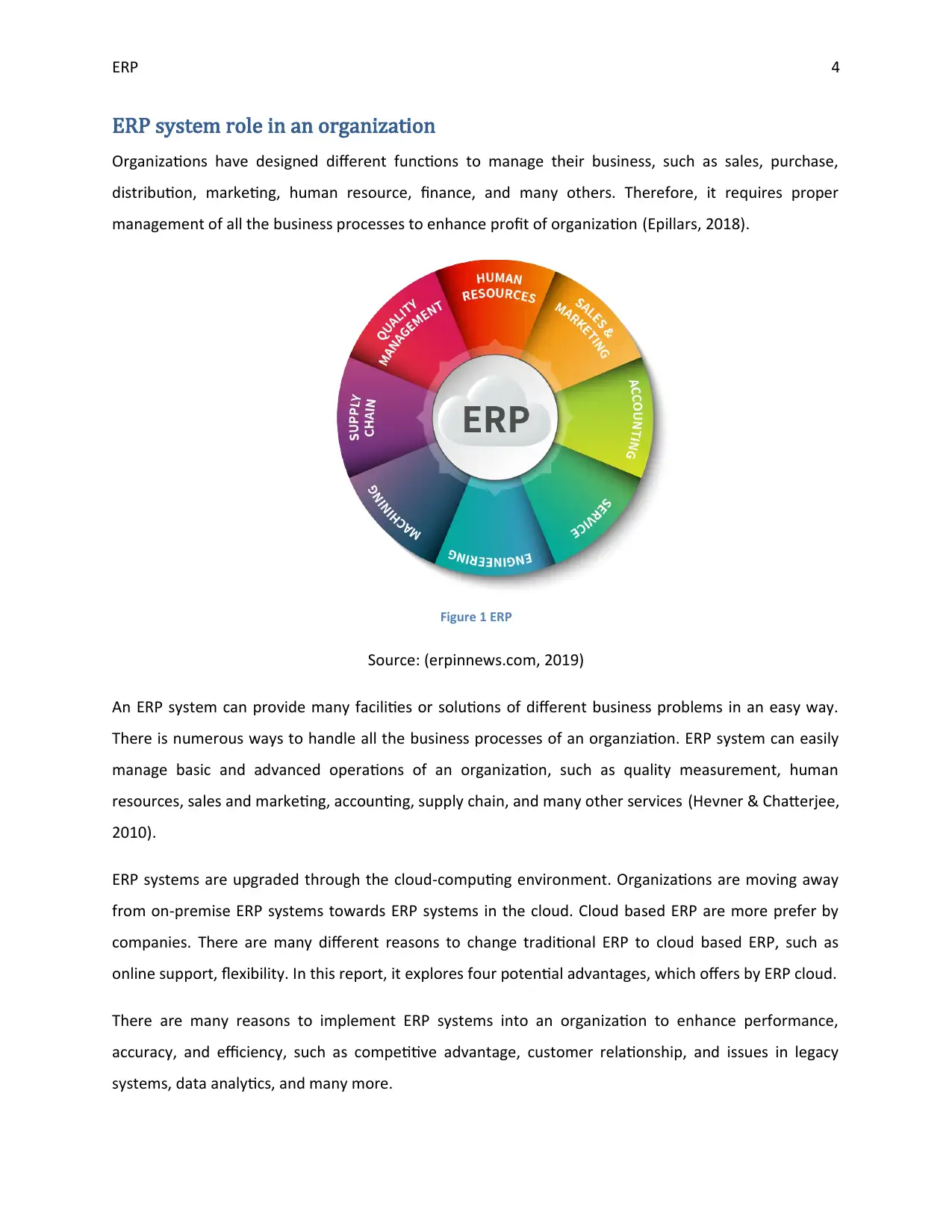
ERP 4
ERP system role in an organization
Organizations have designed different functions to manage their business, such as sales, purchase,
distribution, marketing, human resource, finance, and many others. Therefore, it requires proper
management of all the business processes to enhance profit of organization (Epillars, 2018).
Figure 1 ERP
Source: (erpinnews.com, 2019)
An ERP system can provide many facilities or solutions of different business problems in an easy way.
There is numerous ways to handle all the business processes of an organziation. ERP system can easily
manage basic and advanced operations of an organization, such as quality measurement, human
resources, sales and marketing, accounting, supply chain, and many other services (Hevner & Chatterjee,
2010).
ERP systems are upgraded through the cloud-computing environment. Organizations are moving away
from on-premise ERP systems towards ERP systems in the cloud. Cloud based ERP are more prefer by
companies. There are many different reasons to change traditional ERP to cloud based ERP, such as
online support, flexibility. In this report, it explores four potential advantages, which offers by ERP cloud.
There are many reasons to implement ERP systems into an organization to enhance performance,
accuracy, and efficiency, such as competitive advantage, customer relationship, and issues in legacy
systems, data analytics, and many more.
ERP system role in an organization
Organizations have designed different functions to manage their business, such as sales, purchase,
distribution, marketing, human resource, finance, and many others. Therefore, it requires proper
management of all the business processes to enhance profit of organization (Epillars, 2018).
Figure 1 ERP
Source: (erpinnews.com, 2019)
An ERP system can provide many facilities or solutions of different business problems in an easy way.
There is numerous ways to handle all the business processes of an organziation. ERP system can easily
manage basic and advanced operations of an organization, such as quality measurement, human
resources, sales and marketing, accounting, supply chain, and many other services (Hevner & Chatterjee,
2010).
ERP systems are upgraded through the cloud-computing environment. Organizations are moving away
from on-premise ERP systems towards ERP systems in the cloud. Cloud based ERP are more prefer by
companies. There are many different reasons to change traditional ERP to cloud based ERP, such as
online support, flexibility. In this report, it explores four potential advantages, which offers by ERP cloud.
There are many reasons to implement ERP systems into an organization to enhance performance,
accuracy, and efficiency, such as competitive advantage, customer relationship, and issues in legacy
systems, data analytics, and many more.
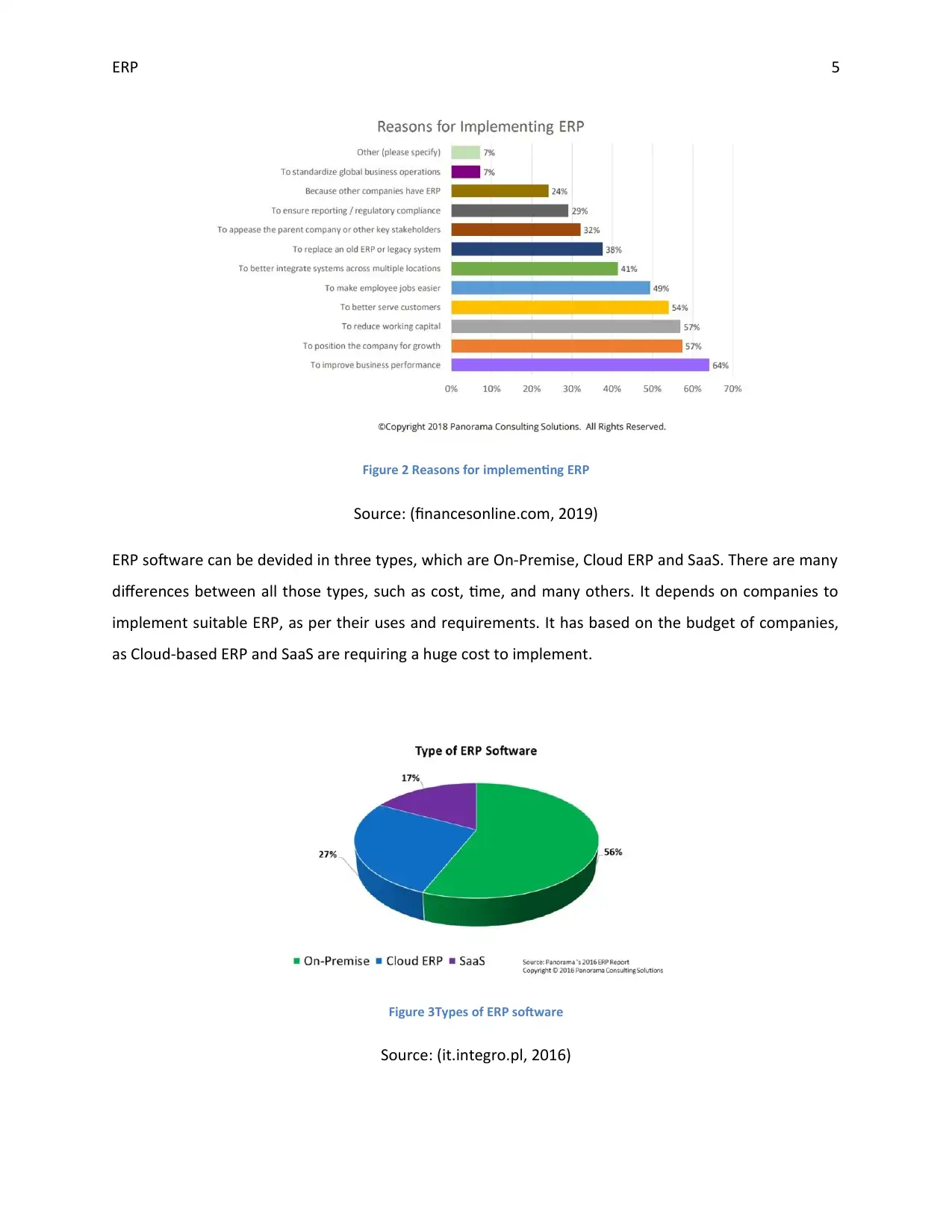
ERP 5
Figure 2 Reasons for implementing ERP
Source: (financesonline.com, 2019)
ERP software can be devided in three types, which are On-Premise, Cloud ERP and SaaS. There are many
differences between all those types, such as cost, time, and many others. It depends on companies to
implement suitable ERP, as per their uses and requirements. It has based on the budget of companies,
as Cloud-based ERP and SaaS are requiring a huge cost to implement.
Figure 3Types of ERP software
Source: (it.integro.pl, 2016)
Figure 2 Reasons for implementing ERP
Source: (financesonline.com, 2019)
ERP software can be devided in three types, which are On-Premise, Cloud ERP and SaaS. There are many
differences between all those types, such as cost, time, and many others. It depends on companies to
implement suitable ERP, as per their uses and requirements. It has based on the budget of companies,
as Cloud-based ERP and SaaS are requiring a huge cost to implement.
Figure 3Types of ERP software
Source: (it.integro.pl, 2016)
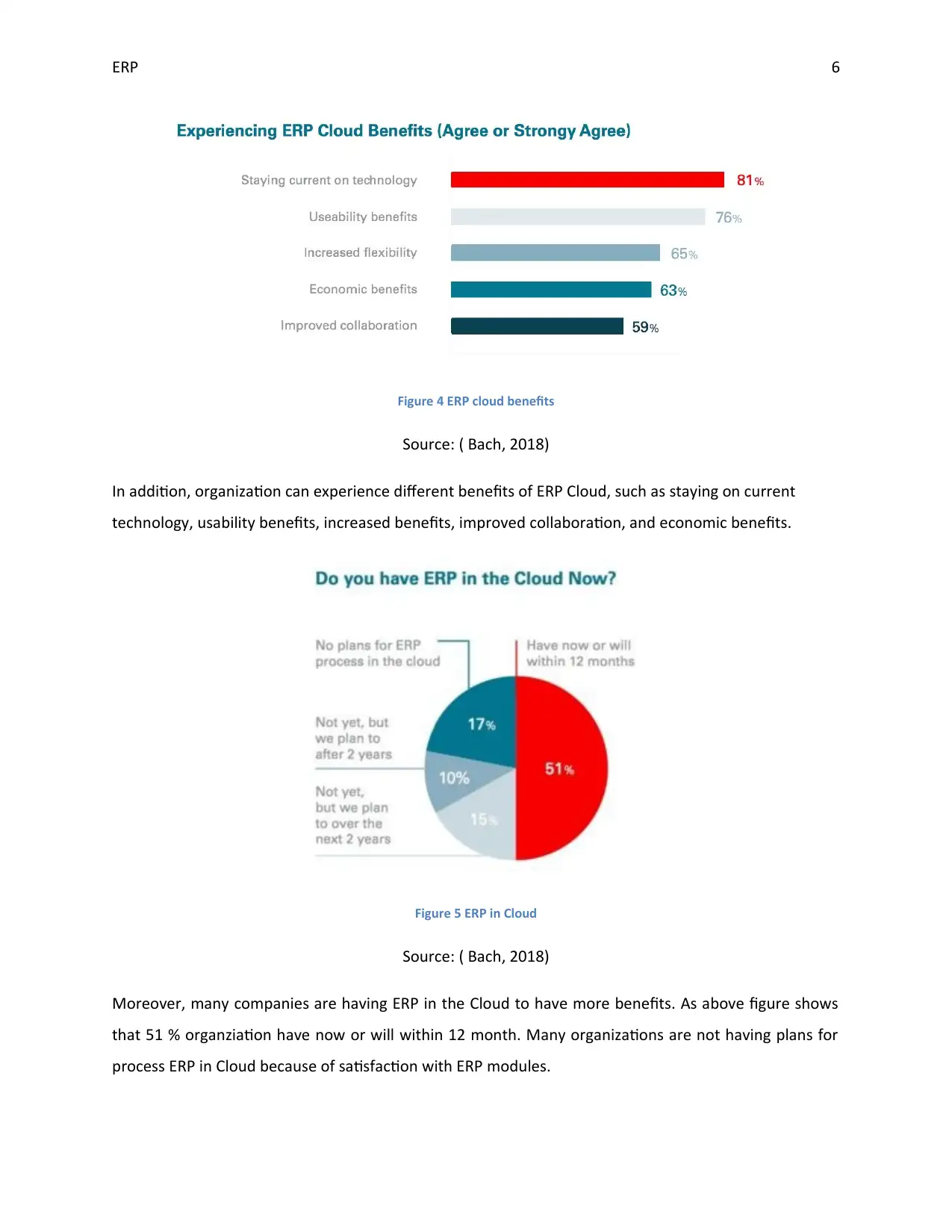
ERP 6
Figure 4 ERP cloud benefits
Source: ( Bach, 2018)
In addition, organization can experience different benefits of ERP Cloud, such as staying on current
technology, usability benefits, increased benefits, improved collaboration, and economic benefits.
Figure 5 ERP in Cloud
Source: ( Bach, 2018)
Moreover, many companies are having ERP in the Cloud to have more benefits. As above figure shows
that 51 % organziation have now or will within 12 month. Many organizations are not having plans for
process ERP in Cloud because of satisfaction with ERP modules.
Figure 4 ERP cloud benefits
Source: ( Bach, 2018)
In addition, organization can experience different benefits of ERP Cloud, such as staying on current
technology, usability benefits, increased benefits, improved collaboration, and economic benefits.
Figure 5 ERP in Cloud
Source: ( Bach, 2018)
Moreover, many companies are having ERP in the Cloud to have more benefits. As above figure shows
that 51 % organziation have now or will within 12 month. Many organizations are not having plans for
process ERP in Cloud because of satisfaction with ERP modules.
Paraphrase This Document
Need a fresh take? Get an instant paraphrase of this document with our AI Paraphraser
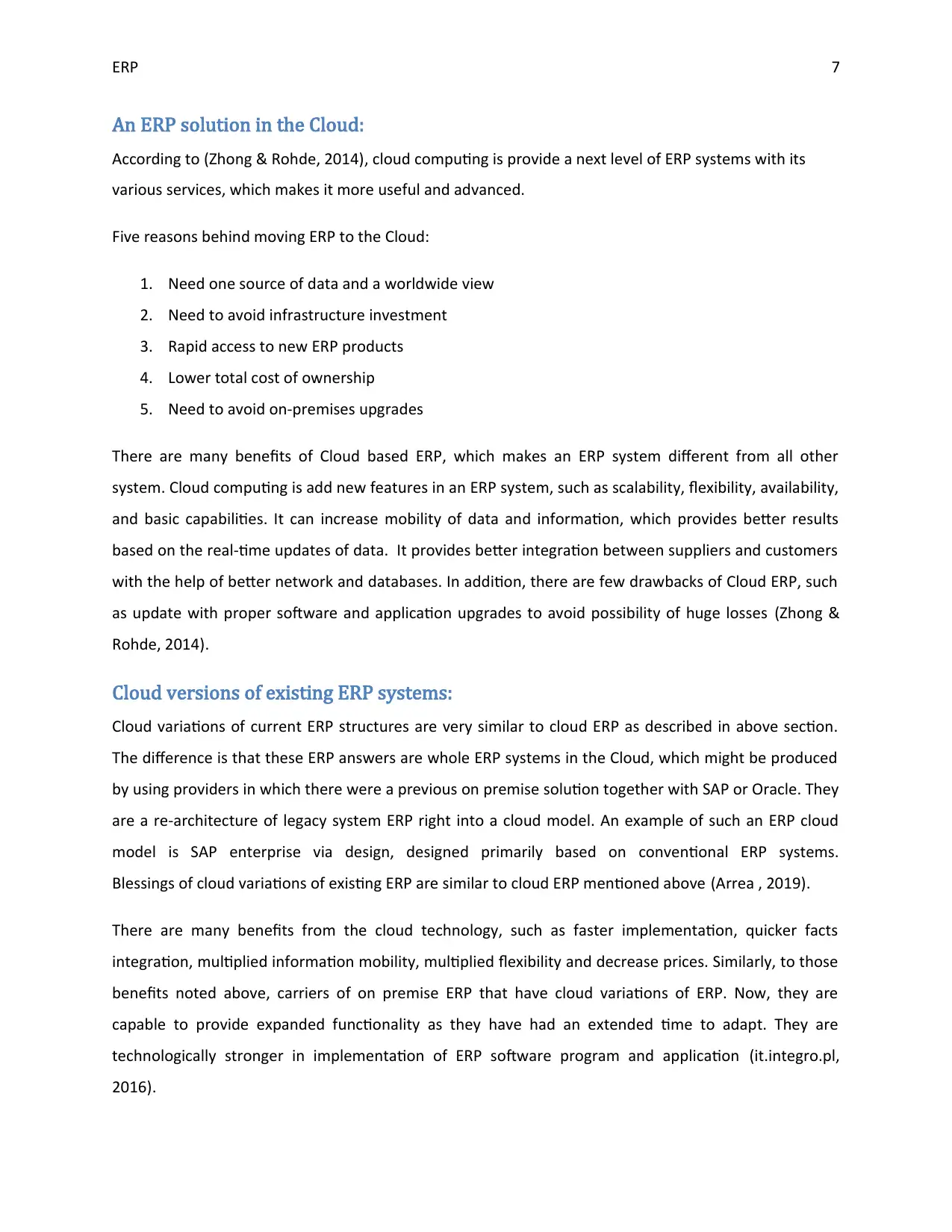
ERP 7
An ERP solution in the Cloud:
According to (Zhong & Rohde, 2014), cloud computing is provide a next level of ERP systems with its
various services, which makes it more useful and advanced.
Five reasons behind moving ERP to the Cloud:
1. Need one source of data and a worldwide view
2. Need to avoid infrastructure investment
3. Rapid access to new ERP products
4. Lower total cost of ownership
5. Need to avoid on-premises upgrades
There are many benefits of Cloud based ERP, which makes an ERP system different from all other
system. Cloud computing is add new features in an ERP system, such as scalability, flexibility, availability,
and basic capabilities. It can increase mobility of data and information, which provides better results
based on the real-time updates of data. It provides better integration between suppliers and customers
with the help of better network and databases. In addition, there are few drawbacks of Cloud ERP, such
as update with proper software and application upgrades to avoid possibility of huge losses (Zhong &
Rohde, 2014).
Cloud versions of existing ERP systems:
Cloud variations of current ERP structures are very similar to cloud ERP as described in above section.
The difference is that these ERP answers are whole ERP systems in the Cloud, which might be produced
by using providers in which there were a previous on premise solution together with SAP or Oracle. They
are a re-architecture of legacy system ERP right into a cloud model. An example of such an ERP cloud
model is SAP enterprise via design, designed primarily based on conventional ERP systems.
Blessings of cloud variations of existing ERP are similar to cloud ERP mentioned above (Arrea , 2019).
There are many benefits from the cloud technology, such as faster implementation, quicker facts
integration, multiplied information mobility, multiplied flexibility and decrease prices. Similarly, to those
benefits noted above, carriers of on premise ERP that have cloud variations of ERP. Now, they are
capable to provide expanded functionality as they have had an extended time to adapt. They are
technologically stronger in implementation of ERP software program and application (it.integro.pl,
2016).
An ERP solution in the Cloud:
According to (Zhong & Rohde, 2014), cloud computing is provide a next level of ERP systems with its
various services, which makes it more useful and advanced.
Five reasons behind moving ERP to the Cloud:
1. Need one source of data and a worldwide view
2. Need to avoid infrastructure investment
3. Rapid access to new ERP products
4. Lower total cost of ownership
5. Need to avoid on-premises upgrades
There are many benefits of Cloud based ERP, which makes an ERP system different from all other
system. Cloud computing is add new features in an ERP system, such as scalability, flexibility, availability,
and basic capabilities. It can increase mobility of data and information, which provides better results
based on the real-time updates of data. It provides better integration between suppliers and customers
with the help of better network and databases. In addition, there are few drawbacks of Cloud ERP, such
as update with proper software and application upgrades to avoid possibility of huge losses (Zhong &
Rohde, 2014).
Cloud versions of existing ERP systems:
Cloud variations of current ERP structures are very similar to cloud ERP as described in above section.
The difference is that these ERP answers are whole ERP systems in the Cloud, which might be produced
by using providers in which there were a previous on premise solution together with SAP or Oracle. They
are a re-architecture of legacy system ERP right into a cloud model. An example of such an ERP cloud
model is SAP enterprise via design, designed primarily based on conventional ERP systems.
Blessings of cloud variations of existing ERP are similar to cloud ERP mentioned above (Arrea , 2019).
There are many benefits from the cloud technology, such as faster implementation, quicker facts
integration, multiplied information mobility, multiplied flexibility and decrease prices. Similarly, to those
benefits noted above, carriers of on premise ERP that have cloud variations of ERP. Now, they are
capable to provide expanded functionality as they have had an extended time to adapt. They are
technologically stronger in implementation of ERP software program and application (it.integro.pl,
2016).
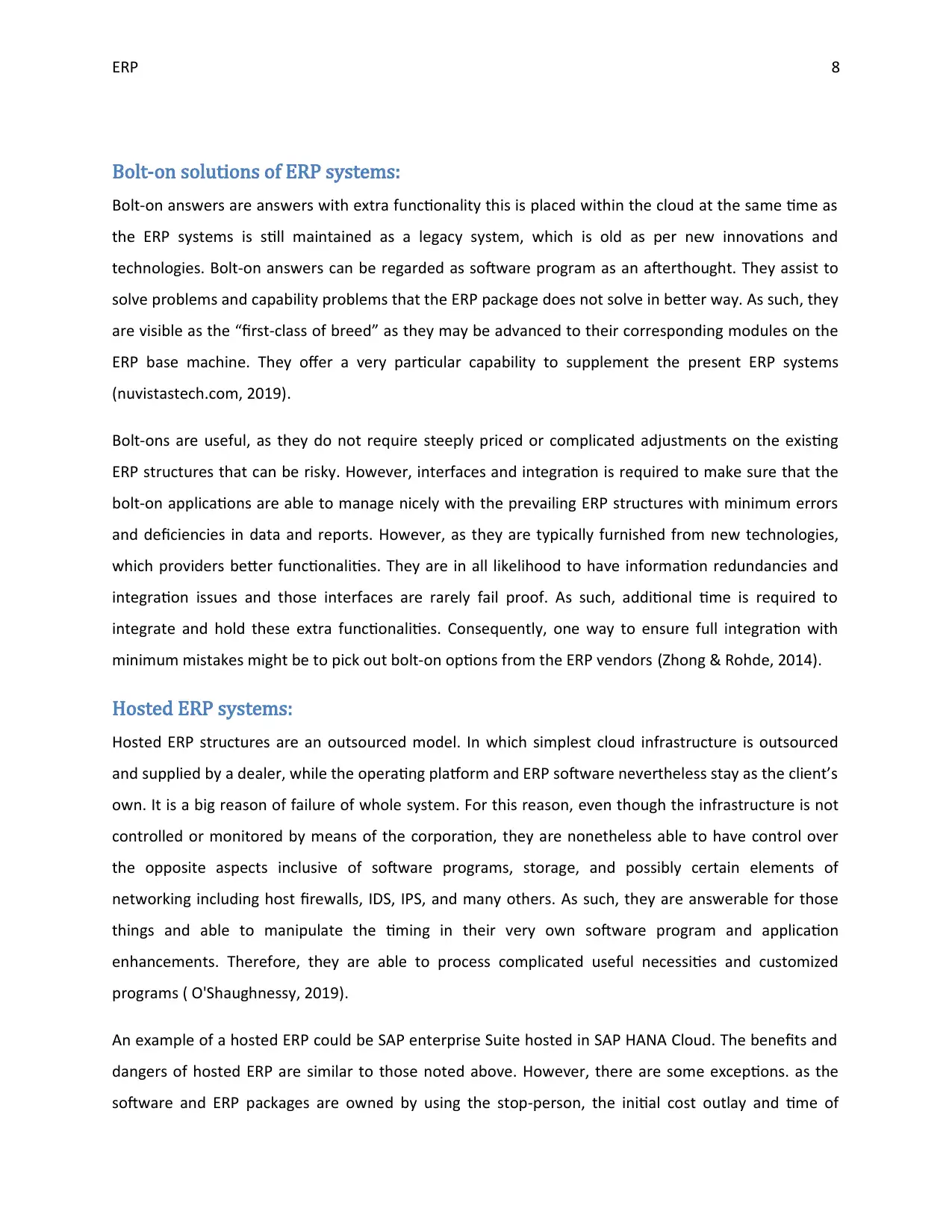
ERP 8
Bolt-on solutions of ERP systems:
Bolt-on answers are answers with extra functionality this is placed within the cloud at the same time as
the ERP systems is still maintained as a legacy system, which is old as per new innovations and
technologies. Bolt-on answers can be regarded as software program as an afterthought. They assist to
solve problems and capability problems that the ERP package does not solve in better way. As such, they
are visible as the “first-class of breed” as they may be advanced to their corresponding modules on the
ERP base machine. They offer a very particular capability to supplement the present ERP systems
(nuvistastech.com, 2019).
Bolt-ons are useful, as they do not require steeply priced or complicated adjustments on the existing
ERP structures that can be risky. However, interfaces and integration is required to make sure that the
bolt-on applications are able to manage nicely with the prevailing ERP structures with minimum errors
and deficiencies in data and reports. However, as they are typically furnished from new technologies,
which providers better functionalities. They are in all likelihood to have information redundancies and
integration issues and those interfaces are rarely fail proof. As such, additional time is required to
integrate and hold these extra functionalities. Consequently, one way to ensure full integration with
minimum mistakes might be to pick out bolt-on options from the ERP vendors (Zhong & Rohde, 2014).
Hosted ERP systems:
Hosted ERP structures are an outsourced model. In which simplest cloud infrastructure is outsourced
and supplied by a dealer, while the operating platform and ERP software nevertheless stay as the client’s
own. It is a big reason of failure of whole system. For this reason, even though the infrastructure is not
controlled or monitored by means of the corporation, they are nonetheless able to have control over
the opposite aspects inclusive of software programs, storage, and possibly certain elements of
networking including host firewalls, IDS, IPS, and many others. As such, they are answerable for those
things and able to manipulate the timing in their very own software program and application
enhancements. Therefore, they are able to process complicated useful necessities and customized
programs ( O'Shaughnessy, 2019).
An example of a hosted ERP could be SAP enterprise Suite hosted in SAP HANA Cloud. The benefits and
dangers of hosted ERP are similar to those noted above. However, there are some exceptions. as the
software and ERP packages are owned by using the stop-person, the initial cost outlay and time of
Bolt-on solutions of ERP systems:
Bolt-on answers are answers with extra functionality this is placed within the cloud at the same time as
the ERP systems is still maintained as a legacy system, which is old as per new innovations and
technologies. Bolt-on answers can be regarded as software program as an afterthought. They assist to
solve problems and capability problems that the ERP package does not solve in better way. As such, they
are visible as the “first-class of breed” as they may be advanced to their corresponding modules on the
ERP base machine. They offer a very particular capability to supplement the present ERP systems
(nuvistastech.com, 2019).
Bolt-ons are useful, as they do not require steeply priced or complicated adjustments on the existing
ERP structures that can be risky. However, interfaces and integration is required to make sure that the
bolt-on applications are able to manage nicely with the prevailing ERP structures with minimum errors
and deficiencies in data and reports. However, as they are typically furnished from new technologies,
which providers better functionalities. They are in all likelihood to have information redundancies and
integration issues and those interfaces are rarely fail proof. As such, additional time is required to
integrate and hold these extra functionalities. Consequently, one way to ensure full integration with
minimum mistakes might be to pick out bolt-on options from the ERP vendors (Zhong & Rohde, 2014).
Hosted ERP systems:
Hosted ERP structures are an outsourced model. In which simplest cloud infrastructure is outsourced
and supplied by a dealer, while the operating platform and ERP software nevertheless stay as the client’s
own. It is a big reason of failure of whole system. For this reason, even though the infrastructure is not
controlled or monitored by means of the corporation, they are nonetheless able to have control over
the opposite aspects inclusive of software programs, storage, and possibly certain elements of
networking including host firewalls, IDS, IPS, and many others. As such, they are answerable for those
things and able to manipulate the timing in their very own software program and application
enhancements. Therefore, they are able to process complicated useful necessities and customized
programs ( O'Shaughnessy, 2019).
An example of a hosted ERP could be SAP enterprise Suite hosted in SAP HANA Cloud. The benefits and
dangers of hosted ERP are similar to those noted above. However, there are some exceptions. as the
software and ERP packages are owned by using the stop-person, the initial cost outlay and time of

ERP 9
implementation is may not always be significantly cheaper or faster compared to other cloud primarily
based ERP. There may be additionally an additional integration step required to configure software
program and programs to be compatible with the host cloud vendor. This would rely upon coordination
and dealer response time and costs. However, although implementation time is barely longer than cloud
ERP, it is far still shorter than the conventional ERP (Kravchenko, 2018).
ERP implementation stages
There are nine stages of ERP implementation and every stage is important to successful implementation
of ERP systems. In below diagram, all nine stage are shows and they are work in a flow with dependency
of each part on another one.
Figure 6 ERP implementation process
Source: (Tondon, 2016)
In addition, it is necessary to know about the need of ERP in Cloud. It provides needs of ERP to
companies. Next stage is change management, which makes a huge impact on the new technology, such
as ERP, AI, and many others (rasahmi, 2012). It is necessary to find that business process re-engineering
is required or not for company. If it is required then next stage is finding suitable ERP Vendor. It is an
analysis part, which is necessary to implement ERP in Cloud. Companies can use consultant for it. They
can provide better options through understands needs of company. Next stage is choosing a team and
implementation is may not always be significantly cheaper or faster compared to other cloud primarily
based ERP. There may be additionally an additional integration step required to configure software
program and programs to be compatible with the host cloud vendor. This would rely upon coordination
and dealer response time and costs. However, although implementation time is barely longer than cloud
ERP, it is far still shorter than the conventional ERP (Kravchenko, 2018).
ERP implementation stages
There are nine stages of ERP implementation and every stage is important to successful implementation
of ERP systems. In below diagram, all nine stage are shows and they are work in a flow with dependency
of each part on another one.
Figure 6 ERP implementation process
Source: (Tondon, 2016)
In addition, it is necessary to know about the need of ERP in Cloud. It provides needs of ERP to
companies. Next stage is change management, which makes a huge impact on the new technology, such
as ERP, AI, and many others (rasahmi, 2012). It is necessary to find that business process re-engineering
is required or not for company. If it is required then next stage is finding suitable ERP Vendor. It is an
analysis part, which is necessary to implement ERP in Cloud. Companies can use consultant for it. They
can provide better options through understands needs of company. Next stage is choosing a team and
Secure Best Marks with AI Grader
Need help grading? Try our AI Grader for instant feedback on your assignments.
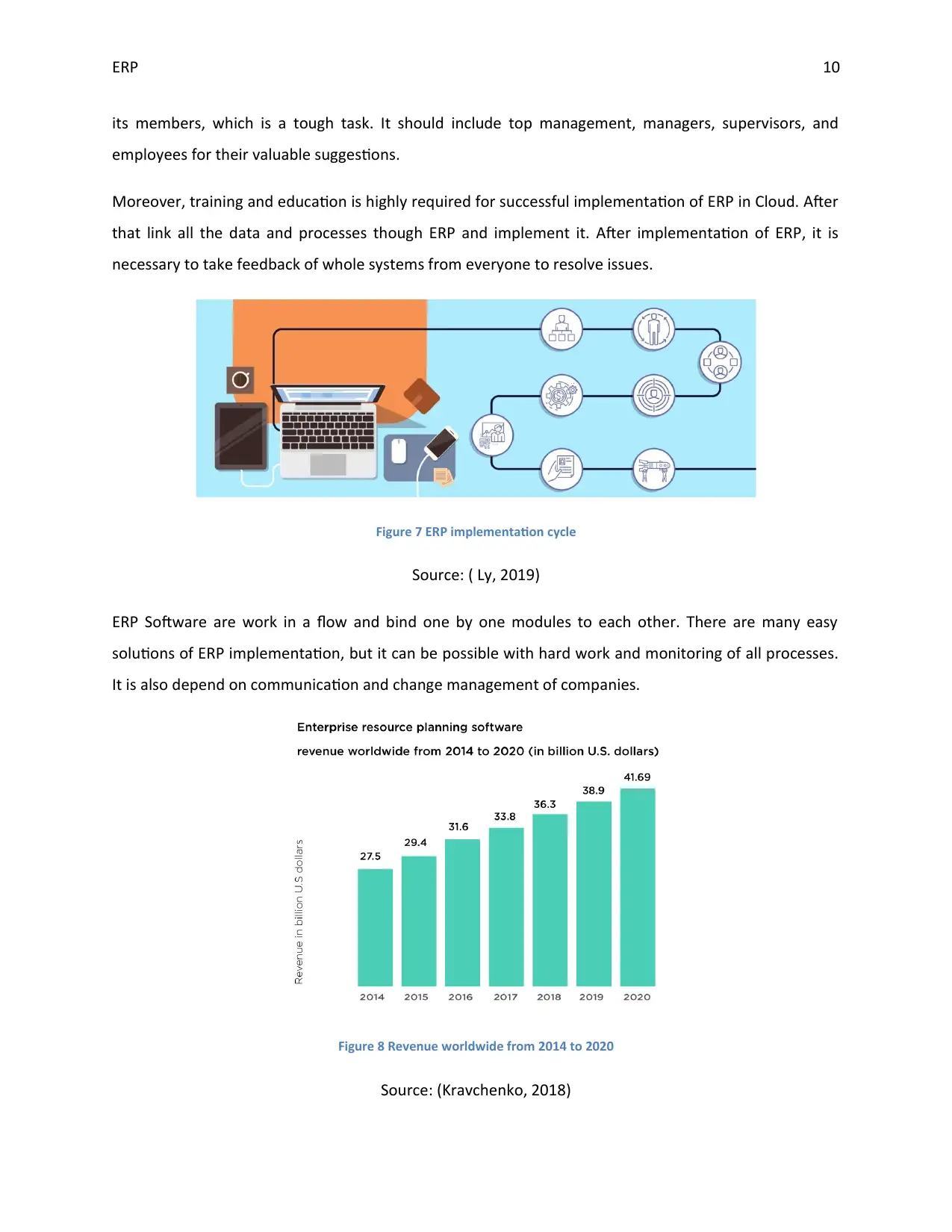
ERP 10
its members, which is a tough task. It should include top management, managers, supervisors, and
employees for their valuable suggestions.
Moreover, training and education is highly required for successful implementation of ERP in Cloud. After
that link all the data and processes though ERP and implement it. After implementation of ERP, it is
necessary to take feedback of whole systems from everyone to resolve issues.
Figure 7 ERP implementation cycle
Source: ( Ly, 2019)
ERP Software are work in a flow and bind one by one modules to each other. There are many easy
solutions of ERP implementation, but it can be possible with hard work and monitoring of all processes.
It is also depend on communication and change management of companies.
Figure 8 Revenue worldwide from 2014 to 2020
Source: (Kravchenko, 2018)
its members, which is a tough task. It should include top management, managers, supervisors, and
employees for their valuable suggestions.
Moreover, training and education is highly required for successful implementation of ERP in Cloud. After
that link all the data and processes though ERP and implement it. After implementation of ERP, it is
necessary to take feedback of whole systems from everyone to resolve issues.
Figure 7 ERP implementation cycle
Source: ( Ly, 2019)
ERP Software are work in a flow and bind one by one modules to each other. There are many easy
solutions of ERP implementation, but it can be possible with hard work and monitoring of all processes.
It is also depend on communication and change management of companies.
Figure 8 Revenue worldwide from 2014 to 2020
Source: (Kravchenko, 2018)
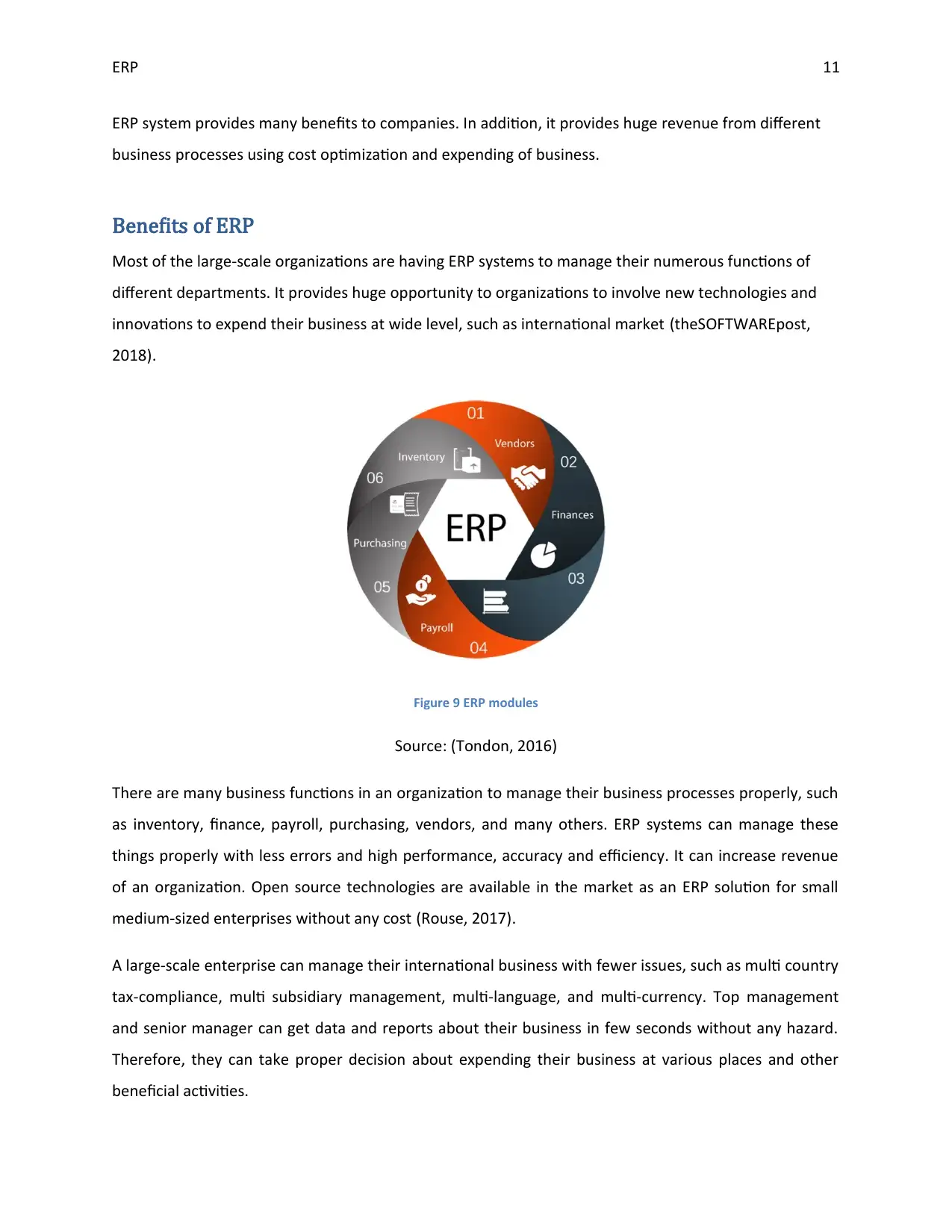
ERP 11
ERP system provides many benefits to companies. In addition, it provides huge revenue from different
business processes using cost optimization and expending of business.
Benefits of ERP
Most of the large-scale organizations are having ERP systems to manage their numerous functions of
different departments. It provides huge opportunity to organizations to involve new technologies and
innovations to expend their business at wide level, such as international market (theSOFTWAREpost,
2018).
Figure 9 ERP modules
Source: (Tondon, 2016)
There are many business functions in an organization to manage their business processes properly, such
as inventory, finance, payroll, purchasing, vendors, and many others. ERP systems can manage these
things properly with less errors and high performance, accuracy and efficiency. It can increase revenue
of an organization. Open source technologies are available in the market as an ERP solution for small
medium-sized enterprises without any cost (Rouse, 2017).
A large-scale enterprise can manage their international business with fewer issues, such as multi country
tax-compliance, multi subsidiary management, multi-language, and multi-currency. Top management
and senior manager can get data and reports about their business in few seconds without any hazard.
Therefore, they can take proper decision about expending their business at various places and other
beneficial activities.
ERP system provides many benefits to companies. In addition, it provides huge revenue from different
business processes using cost optimization and expending of business.
Benefits of ERP
Most of the large-scale organizations are having ERP systems to manage their numerous functions of
different departments. It provides huge opportunity to organizations to involve new technologies and
innovations to expend their business at wide level, such as international market (theSOFTWAREpost,
2018).
Figure 9 ERP modules
Source: (Tondon, 2016)
There are many business functions in an organization to manage their business processes properly, such
as inventory, finance, payroll, purchasing, vendors, and many others. ERP systems can manage these
things properly with less errors and high performance, accuracy and efficiency. It can increase revenue
of an organization. Open source technologies are available in the market as an ERP solution for small
medium-sized enterprises without any cost (Rouse, 2017).
A large-scale enterprise can manage their international business with fewer issues, such as multi country
tax-compliance, multi subsidiary management, multi-language, and multi-currency. Top management
and senior manager can get data and reports about their business in few seconds without any hazard.
Therefore, they can take proper decision about expending their business at various places and other
beneficial activities.
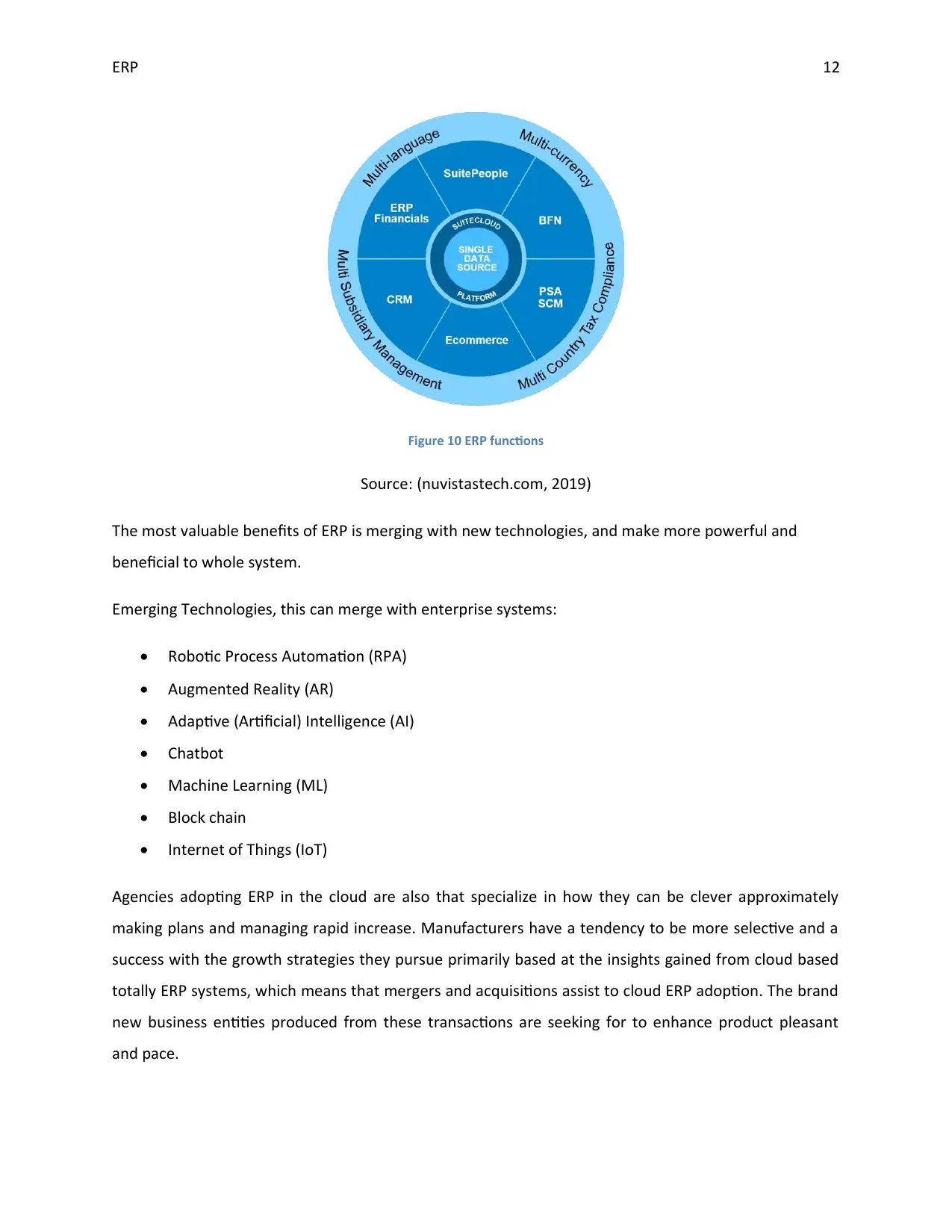
ERP 12
Figure 10 ERP functions
Source: (nuvistastech.com, 2019)
The most valuable benefits of ERP is merging with new technologies, and make more powerful and
beneficial to whole system.
Emerging Technologies, this can merge with enterprise systems:
Robotic Process Automation (RPA)
Augmented Reality (AR)
Adaptive (Artificial) Intelligence (AI)
Chatbot
Machine Learning (ML)
Block chain
Internet of Things (IoT)
Agencies adopting ERP in the cloud are also that specialize in how they can be clever approximately
making plans and managing rapid increase. Manufacturers have a tendency to be more selective and a
success with the growth strategies they pursue primarily based at the insights gained from cloud based
totally ERP systems, which means that mergers and acquisitions assist to cloud ERP adoption. The brand
new business entities produced from these transactions are seeking for to enhance product pleasant
and pace.
Figure 10 ERP functions
Source: (nuvistastech.com, 2019)
The most valuable benefits of ERP is merging with new technologies, and make more powerful and
beneficial to whole system.
Emerging Technologies, this can merge with enterprise systems:
Robotic Process Automation (RPA)
Augmented Reality (AR)
Adaptive (Artificial) Intelligence (AI)
Chatbot
Machine Learning (ML)
Block chain
Internet of Things (IoT)
Agencies adopting ERP in the cloud are also that specialize in how they can be clever approximately
making plans and managing rapid increase. Manufacturers have a tendency to be more selective and a
success with the growth strategies they pursue primarily based at the insights gained from cloud based
totally ERP systems, which means that mergers and acquisitions assist to cloud ERP adoption. The brand
new business entities produced from these transactions are seeking for to enhance product pleasant
and pace.
Paraphrase This Document
Need a fresh take? Get an instant paraphrase of this document with our AI Paraphraser
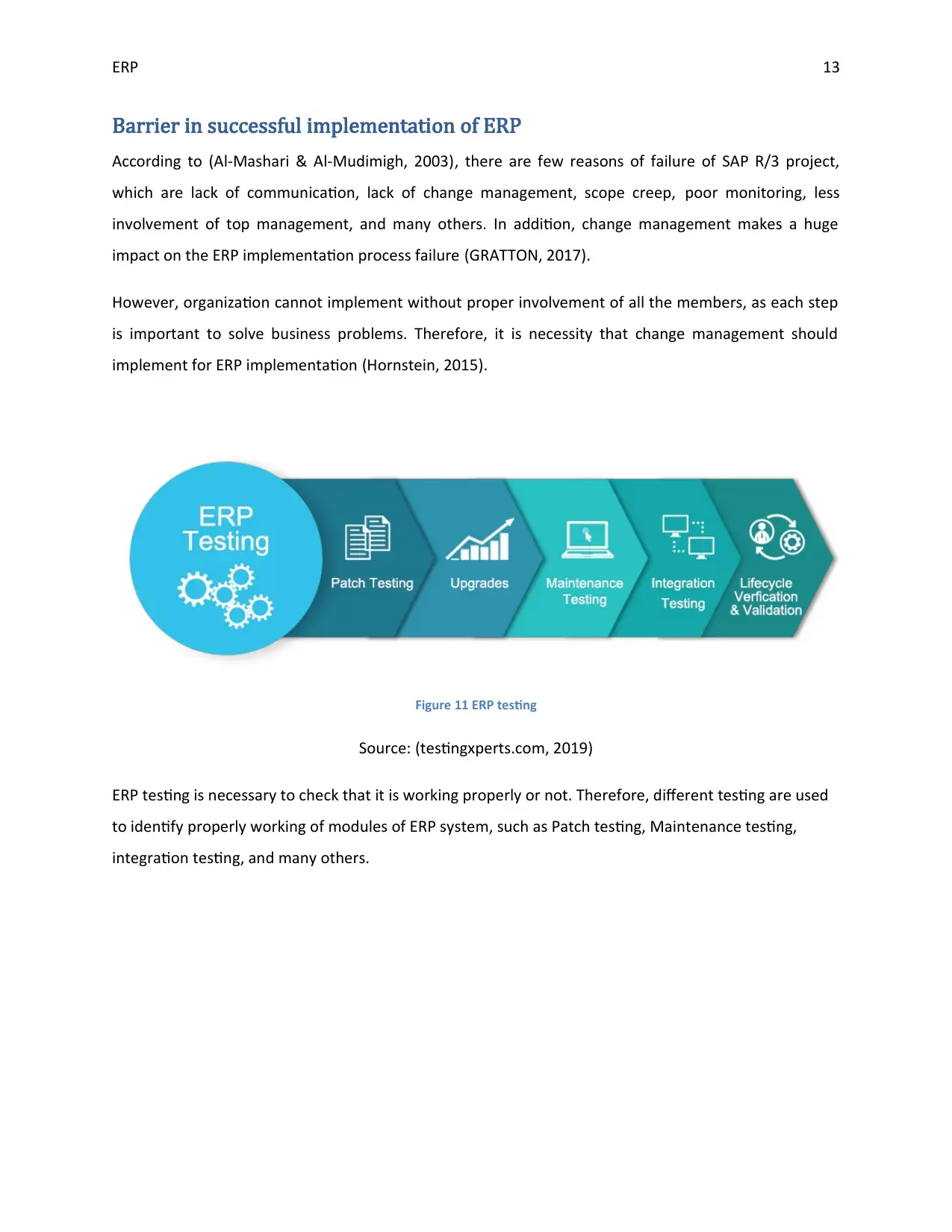
ERP 13
Barrier in successful implementation of ERP
According to (Al-Mashari & Al-Mudimigh, 2003), there are few reasons of failure of SAP R/3 project,
which are lack of communication, lack of change management, scope creep, poor monitoring, less
involvement of top management, and many others. In addition, change management makes a huge
impact on the ERP implementation process failure (GRATTON, 2017).
However, organization cannot implement without proper involvement of all the members, as each step
is important to solve business problems. Therefore, it is necessity that change management should
implement for ERP implementation (Hornstein, 2015).
Figure 11 ERP testing
Source: (testingxperts.com, 2019)
ERP testing is necessary to check that it is working properly or not. Therefore, different testing are used
to identify properly working of modules of ERP system, such as Patch testing, Maintenance testing,
integration testing, and many others.
Barrier in successful implementation of ERP
According to (Al-Mashari & Al-Mudimigh, 2003), there are few reasons of failure of SAP R/3 project,
which are lack of communication, lack of change management, scope creep, poor monitoring, less
involvement of top management, and many others. In addition, change management makes a huge
impact on the ERP implementation process failure (GRATTON, 2017).
However, organization cannot implement without proper involvement of all the members, as each step
is important to solve business problems. Therefore, it is necessity that change management should
implement for ERP implementation (Hornstein, 2015).
Figure 11 ERP testing
Source: (testingxperts.com, 2019)
ERP testing is necessary to check that it is working properly or not. Therefore, different testing are used
to identify properly working of modules of ERP system, such as Patch testing, Maintenance testing,
integration testing, and many others.
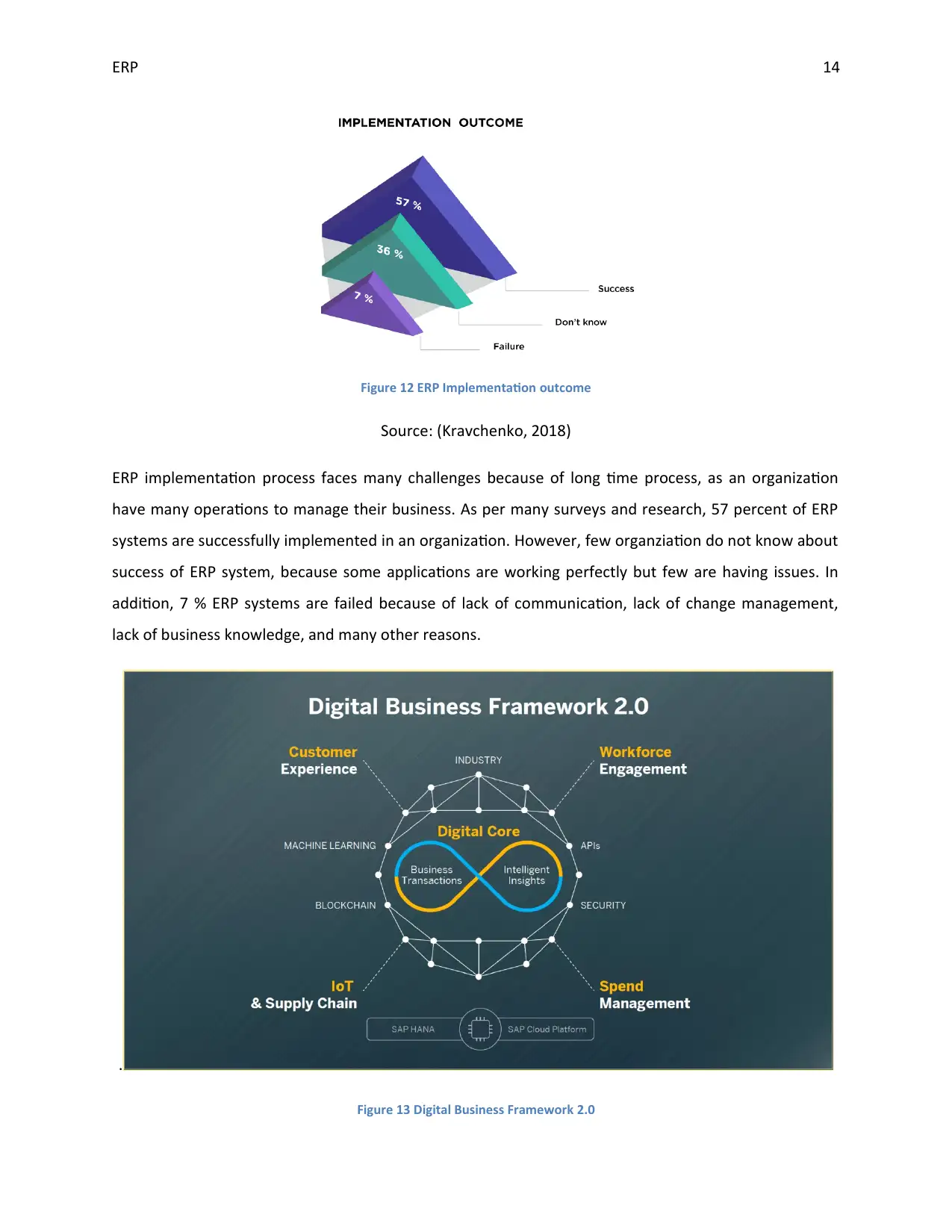
ERP 14
Figure 12 ERP Implementation outcome
Source: (Kravchenko, 2018)
ERP implementation process faces many challenges because of long time process, as an organization
have many operations to manage their business. As per many surveys and research, 57 percent of ERP
systems are successfully implemented in an organization. However, few organziation do not know about
success of ERP system, because some applications are working perfectly but few are having issues. In
addition, 7 % ERP systems are failed because of lack of communication, lack of change management,
lack of business knowledge, and many other reasons.
.
Figure 13 Digital Business Framework 2.0
Figure 12 ERP Implementation outcome
Source: (Kravchenko, 2018)
ERP implementation process faces many challenges because of long time process, as an organization
have many operations to manage their business. As per many surveys and research, 57 percent of ERP
systems are successfully implemented in an organization. However, few organziation do not know about
success of ERP system, because some applications are working perfectly but few are having issues. In
addition, 7 % ERP systems are failed because of lack of communication, lack of change management,
lack of business knowledge, and many other reasons.
.
Figure 13 Digital Business Framework 2.0
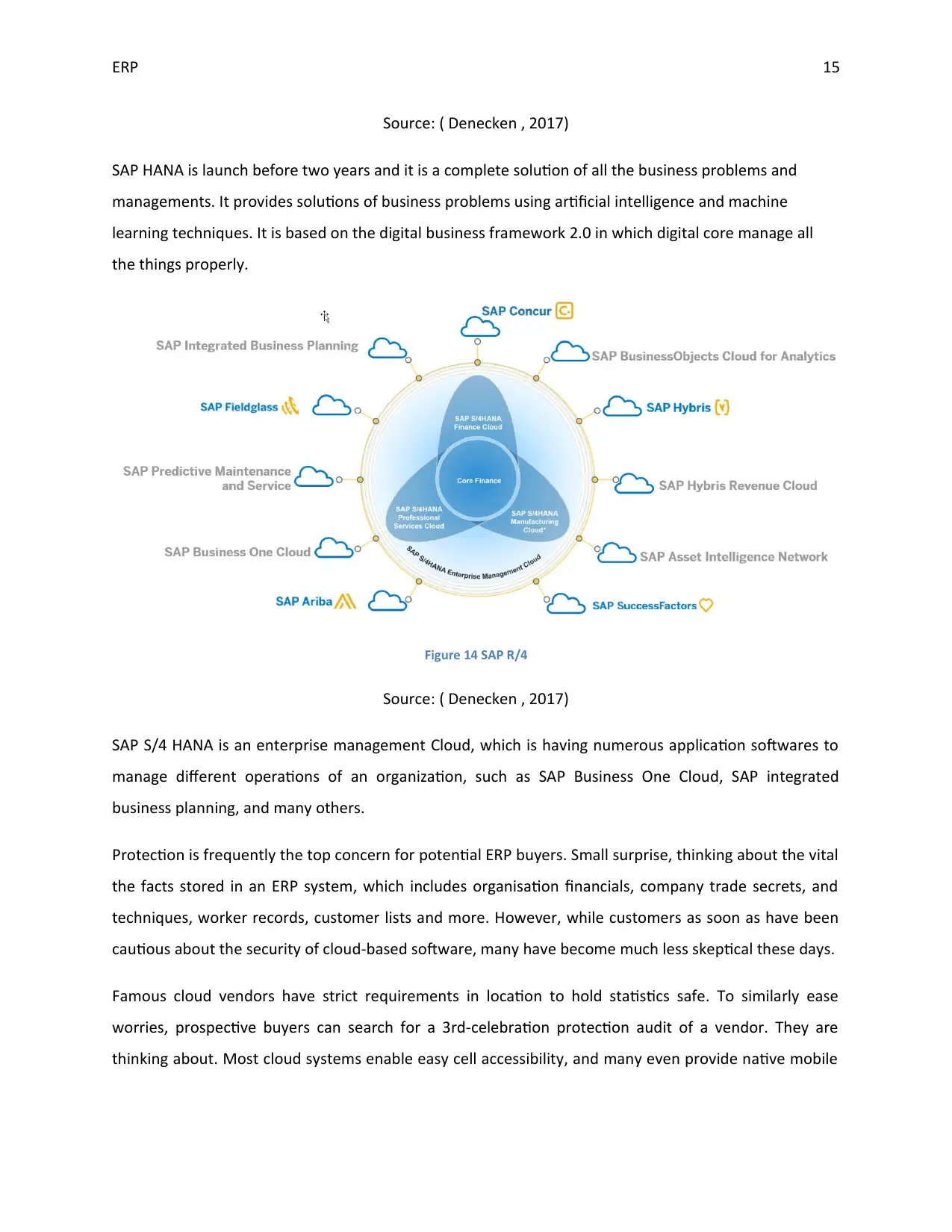
ERP 15
Source: ( Denecken , 2017)
SAP HANA is launch before two years and it is a complete solution of all the business problems and
managements. It provides solutions of business problems using artificial intelligence and machine
learning techniques. It is based on the digital business framework 2.0 in which digital core manage all
the things properly.
Figure 14 SAP R/4
Source: ( Denecken , 2017)
SAP S/4 HANA is an enterprise management Cloud, which is having numerous application softwares to
manage different operations of an organization, such as SAP Business One Cloud, SAP integrated
business planning, and many others.
Protection is frequently the top concern for potential ERP buyers. Small surprise, thinking about the vital
the facts stored in an ERP system, which includes organisation financials, company trade secrets, and
techniques, worker records, customer lists and more. However, while customers as soon as have been
cautious about the security of cloud-based software, many have become much less skeptical these days.
Famous cloud vendors have strict requirements in location to hold statistics safe. To similarly ease
worries, prospective buyers can search for a 3rd-celebration protection audit of a vendor. They are
thinking about. Most cloud systems enable easy cell accessibility, and many even provide native mobile
Source: ( Denecken , 2017)
SAP HANA is launch before two years and it is a complete solution of all the business problems and
managements. It provides solutions of business problems using artificial intelligence and machine
learning techniques. It is based on the digital business framework 2.0 in which digital core manage all
the things properly.
Figure 14 SAP R/4
Source: ( Denecken , 2017)
SAP S/4 HANA is an enterprise management Cloud, which is having numerous application softwares to
manage different operations of an organization, such as SAP Business One Cloud, SAP integrated
business planning, and many others.
Protection is frequently the top concern for potential ERP buyers. Small surprise, thinking about the vital
the facts stored in an ERP system, which includes organisation financials, company trade secrets, and
techniques, worker records, customer lists and more. However, while customers as soon as have been
cautious about the security of cloud-based software, many have become much less skeptical these days.
Famous cloud vendors have strict requirements in location to hold statistics safe. To similarly ease
worries, prospective buyers can search for a 3rd-celebration protection audit of a vendor. They are
thinking about. Most cloud systems enable easy cell accessibility, and many even provide native mobile
Secure Best Marks with AI Grader
Need help grading? Try our AI Grader for instant feedback on your assignments.

ERP 16
apps. However, this ease of get entry to additionally comes with greater safety concerns, especially if
personnel are gaining access to organisation files on their personal mobile gadgets.
In addition, more accessibility approach less customization and cloud ERPs offer much less flexibility for
groups that are seeking to tailor their gadget to their hearts’ content material. However, organizations
with less specialized needs, inclusive of popular consulting companies, can get through just pleasant
with a cloud gadget’s out-of-the-field skills.
Conclusion
It is concluded from the previous parts of this report that cloud-based ERP systems are highly used to
manage different operations of an organization. This report has explored four potential of ERP Cloud
offers to organizations. Cloud ERP is a complete solution of different functions of an organization, such
as sales and marketing, finance, productions, distribution, inventory, customer relationship, human
resources, and many more.
In addition, Cloud based ERP will be implement in most of the organizations in future to improve their
performance and revenue from their operations of them. It can be manage by the ERP clouds in more
easy way. However, implementation process of ERP in cloud is a huge challenge in front of IT persons as
well as for organizations.
This report has described about the implementation processes of ERP in Cloud and different types of
ERP along with its potential advantages for organizations. There are many challenges are faced by the
ERP implementations process, such as data integration, suitable applications, suitable ERP for
organziation, and many others.
SAP R/3 and SAP R/4 HANA are latest version of ERP and these products will helpful to manage
maximum business processes of an organziation with high efficiency, flexibility, and accuracy. It is the
best way to handle different challenges using technologies and innovations. This report has explained
about the latest Cloud ERP system and traditional ERPs.
Finally, it is concluded that cloud-based ERP systems are more feasible to manage various functions of
an organization in well-mannered way. It will enhance the performance of organization and help in their
apps. However, this ease of get entry to additionally comes with greater safety concerns, especially if
personnel are gaining access to organisation files on their personal mobile gadgets.
In addition, more accessibility approach less customization and cloud ERPs offer much less flexibility for
groups that are seeking to tailor their gadget to their hearts’ content material. However, organizations
with less specialized needs, inclusive of popular consulting companies, can get through just pleasant
with a cloud gadget’s out-of-the-field skills.
Conclusion
It is concluded from the previous parts of this report that cloud-based ERP systems are highly used to
manage different operations of an organization. This report has explored four potential of ERP Cloud
offers to organizations. Cloud ERP is a complete solution of different functions of an organization, such
as sales and marketing, finance, productions, distribution, inventory, customer relationship, human
resources, and many more.
In addition, Cloud based ERP will be implement in most of the organizations in future to improve their
performance and revenue from their operations of them. It can be manage by the ERP clouds in more
easy way. However, implementation process of ERP in cloud is a huge challenge in front of IT persons as
well as for organizations.
This report has described about the implementation processes of ERP in Cloud and different types of
ERP along with its potential advantages for organizations. There are many challenges are faced by the
ERP implementations process, such as data integration, suitable applications, suitable ERP for
organziation, and many others.
SAP R/3 and SAP R/4 HANA are latest version of ERP and these products will helpful to manage
maximum business processes of an organziation with high efficiency, flexibility, and accuracy. It is the
best way to handle different challenges using technologies and innovations. This report has explained
about the latest Cloud ERP system and traditional ERPs.
Finally, it is concluded that cloud-based ERP systems are more feasible to manage various functions of
an organization in well-mannered way. It will enhance the performance of organization and help in their

ERP 17
growth and success in future. Cloud ERP will provide scalability in terms of flexibility of storages and
other services.
growth and success in future. Cloud ERP will provide scalability in terms of flexibility of storages and
other services.
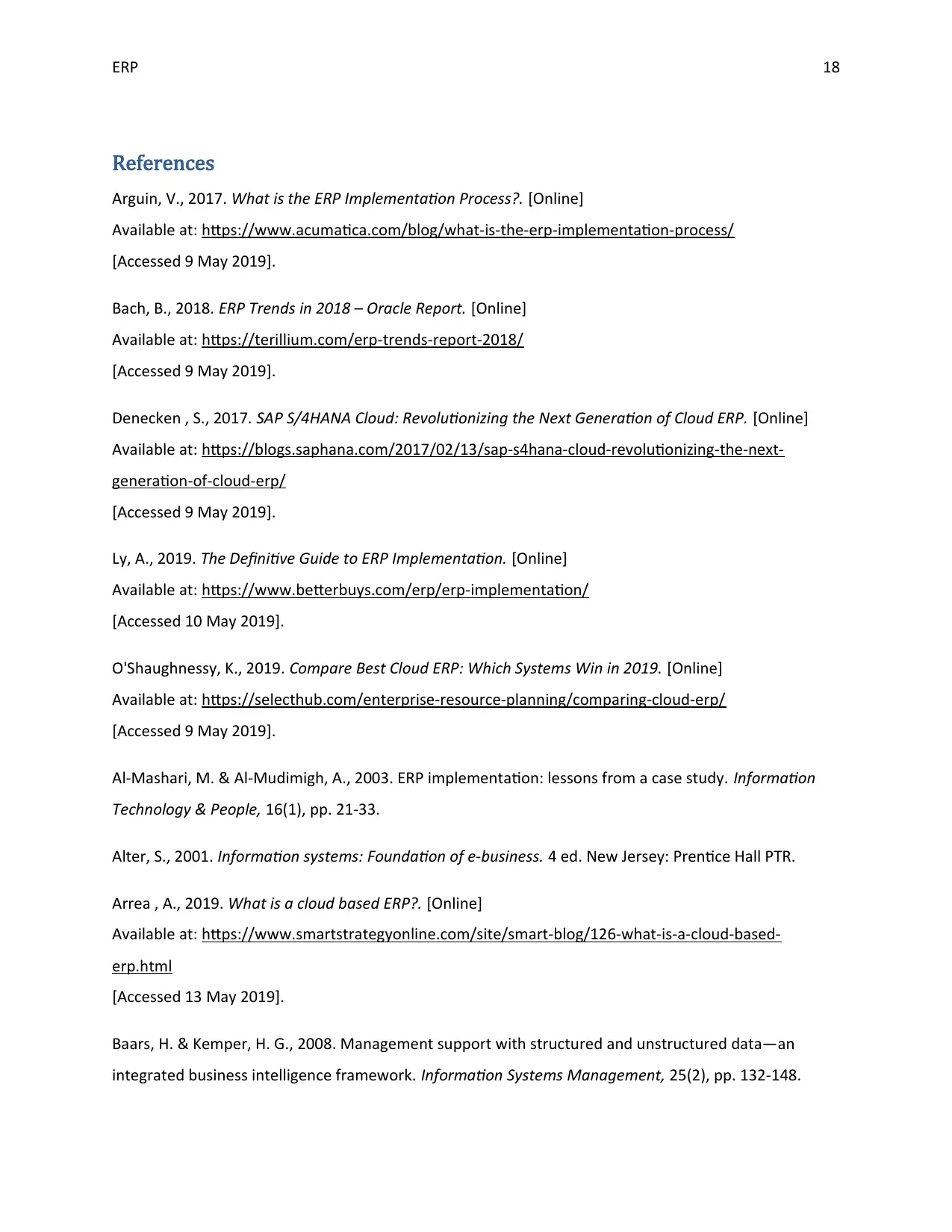
ERP 18
References
Arguin, V., 2017. What is the ERP Implementation Process?. [Online]
Available at: https://www.acumatica.com/blog/what-is-the-erp-implementation-process/
[Accessed 9 May 2019].
Bach, B., 2018. ERP Trends in 2018 – Oracle Report. [Online]
Available at: https://terillium.com/erp-trends-report-2018/
[Accessed 9 May 2019].
Denecken , S., 2017. SAP S/4HANA Cloud: Revolutionizing the Next Generation of Cloud ERP. [Online]
Available at: https://blogs.saphana.com/2017/02/13/sap-s4hana-cloud-revolutionizing-the-next-
generation-of-cloud-erp/
[Accessed 9 May 2019].
Ly, A., 2019. The Definitive Guide to ERP Implementation. [Online]
Available at: https://www.betterbuys.com/erp/erp-implementation/
[Accessed 10 May 2019].
O'Shaughnessy, K., 2019. Compare Best Cloud ERP: Which Systems Win in 2019. [Online]
Available at: https://selecthub.com/enterprise-resource-planning/comparing-cloud-erp/
[Accessed 9 May 2019].
Al-Mashari, M. & Al-Mudimigh, A., 2003. ERP implementation: lessons from a case study. Information
Technology & People, 16(1), pp. 21-33.
Alter, S., 2001. Information systems: Foundation of e-business. 4 ed. New Jersey: Prentice Hall PTR.
Arrea , A., 2019. What is a cloud based ERP?. [Online]
Available at: https://www.smartstrategyonline.com/site/smart-blog/126-what-is-a-cloud-based-
erp.html
[Accessed 13 May 2019].
Baars, H. & Kemper, H. G., 2008. Management support with structured and unstructured data—an
integrated business intelligence framework. Information Systems Management, 25(2), pp. 132-148.
References
Arguin, V., 2017. What is the ERP Implementation Process?. [Online]
Available at: https://www.acumatica.com/blog/what-is-the-erp-implementation-process/
[Accessed 9 May 2019].
Bach, B., 2018. ERP Trends in 2018 – Oracle Report. [Online]
Available at: https://terillium.com/erp-trends-report-2018/
[Accessed 9 May 2019].
Denecken , S., 2017. SAP S/4HANA Cloud: Revolutionizing the Next Generation of Cloud ERP. [Online]
Available at: https://blogs.saphana.com/2017/02/13/sap-s4hana-cloud-revolutionizing-the-next-
generation-of-cloud-erp/
[Accessed 9 May 2019].
Ly, A., 2019. The Definitive Guide to ERP Implementation. [Online]
Available at: https://www.betterbuys.com/erp/erp-implementation/
[Accessed 10 May 2019].
O'Shaughnessy, K., 2019. Compare Best Cloud ERP: Which Systems Win in 2019. [Online]
Available at: https://selecthub.com/enterprise-resource-planning/comparing-cloud-erp/
[Accessed 9 May 2019].
Al-Mashari, M. & Al-Mudimigh, A., 2003. ERP implementation: lessons from a case study. Information
Technology & People, 16(1), pp. 21-33.
Alter, S., 2001. Information systems: Foundation of e-business. 4 ed. New Jersey: Prentice Hall PTR.
Arrea , A., 2019. What is a cloud based ERP?. [Online]
Available at: https://www.smartstrategyonline.com/site/smart-blog/126-what-is-a-cloud-based-
erp.html
[Accessed 13 May 2019].
Baars, H. & Kemper, H. G., 2008. Management support with structured and unstructured data—an
integrated business intelligence framework. Information Systems Management, 25(2), pp. 132-148.
Paraphrase This Document
Need a fresh take? Get an instant paraphrase of this document with our AI Paraphraser
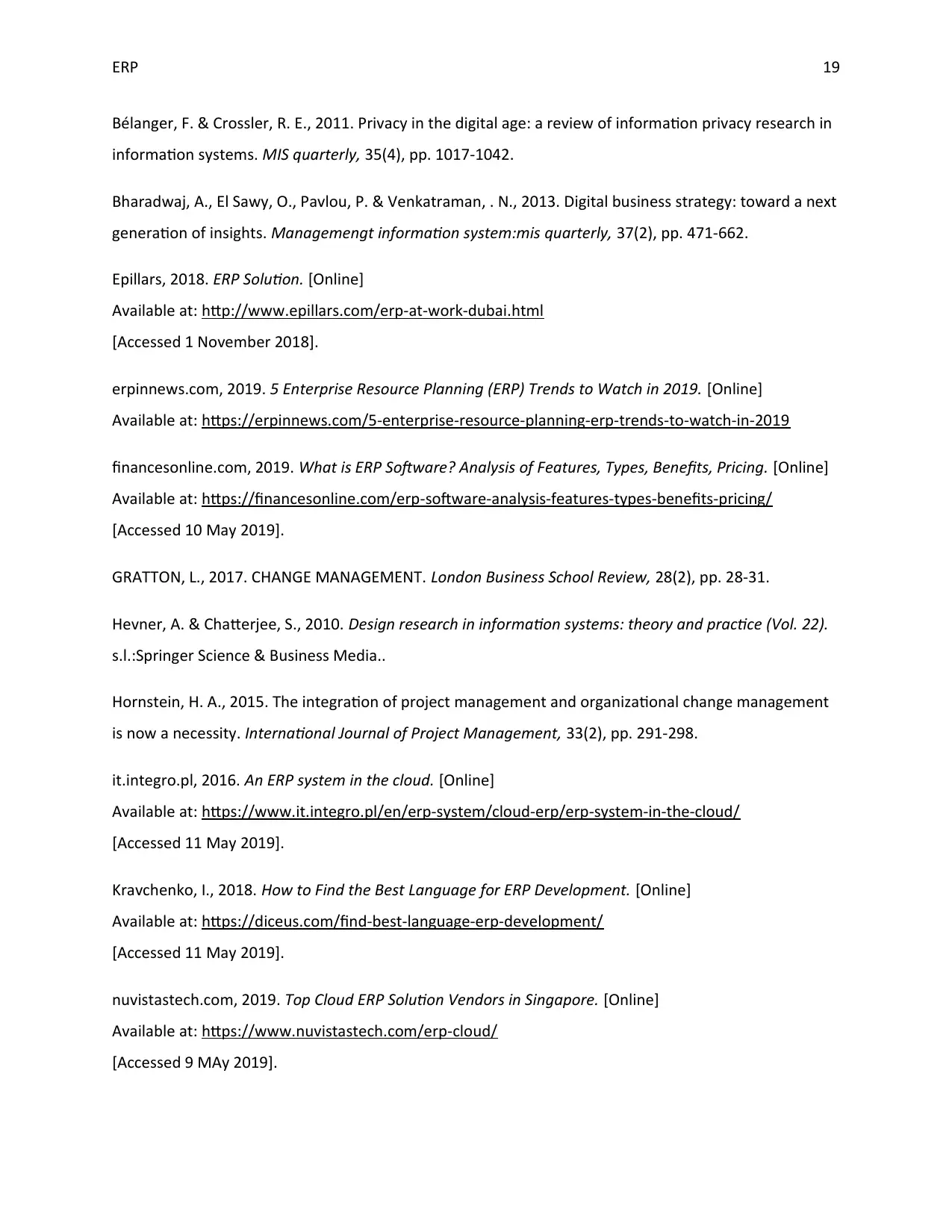
ERP 19
Bélanger, F. & Crossler, R. E., 2011. Privacy in the digital age: a review of information privacy research in
information systems. MIS quarterly, 35(4), pp. 1017-1042.
Bharadwaj, A., El Sawy, O., Pavlou, P. & Venkatraman, . N., 2013. Digital business strategy: toward a next
generation of insights. Managemengt information system:mis quarterly, 37(2), pp. 471-662.
Epillars, 2018. ERP Solution. [Online]
Available at: http://www.epillars.com/erp-at-work-dubai.html
[Accessed 1 November 2018].
erpinnews.com, 2019. 5 Enterprise Resource Planning (ERP) Trends to Watch in 2019. [Online]
Available at: https://erpinnews.com/5-enterprise-resource-planning-erp-trends-to-watch-in-2019
financesonline.com, 2019. What is ERP Software? Analysis of Features, Types, Benefits, Pricing. [Online]
Available at: https://financesonline.com/erp-software-analysis-features-types-benefits-pricing/
[Accessed 10 May 2019].
GRATTON, L., 2017. CHANGE MANAGEMENT. London Business School Review, 28(2), pp. 28-31.
Hevner, A. & Chatterjee, S., 2010. Design research in information systems: theory and practice (Vol. 22).
s.l.:Springer Science & Business Media..
Hornstein, H. A., 2015. The integration of project management and organizational change management
is now a necessity. International Journal of Project Management, 33(2), pp. 291-298.
it.integro.pl, 2016. An ERP system in the cloud. [Online]
Available at: https://www.it.integro.pl/en/erp-system/cloud-erp/erp-system-in-the-cloud/
[Accessed 11 May 2019].
Kravchenko, I., 2018. How to Find the Best Language for ERP Development. [Online]
Available at: https://diceus.com/find-best-language-erp-development/
[Accessed 11 May 2019].
nuvistastech.com, 2019. Top Cloud ERP Solution Vendors in Singapore. [Online]
Available at: https://www.nuvistastech.com/erp-cloud/
[Accessed 9 MAy 2019].
Bélanger, F. & Crossler, R. E., 2011. Privacy in the digital age: a review of information privacy research in
information systems. MIS quarterly, 35(4), pp. 1017-1042.
Bharadwaj, A., El Sawy, O., Pavlou, P. & Venkatraman, . N., 2013. Digital business strategy: toward a next
generation of insights. Managemengt information system:mis quarterly, 37(2), pp. 471-662.
Epillars, 2018. ERP Solution. [Online]
Available at: http://www.epillars.com/erp-at-work-dubai.html
[Accessed 1 November 2018].
erpinnews.com, 2019. 5 Enterprise Resource Planning (ERP) Trends to Watch in 2019. [Online]
Available at: https://erpinnews.com/5-enterprise-resource-planning-erp-trends-to-watch-in-2019
financesonline.com, 2019. What is ERP Software? Analysis of Features, Types, Benefits, Pricing. [Online]
Available at: https://financesonline.com/erp-software-analysis-features-types-benefits-pricing/
[Accessed 10 May 2019].
GRATTON, L., 2017. CHANGE MANAGEMENT. London Business School Review, 28(2), pp. 28-31.
Hevner, A. & Chatterjee, S., 2010. Design research in information systems: theory and practice (Vol. 22).
s.l.:Springer Science & Business Media..
Hornstein, H. A., 2015. The integration of project management and organizational change management
is now a necessity. International Journal of Project Management, 33(2), pp. 291-298.
it.integro.pl, 2016. An ERP system in the cloud. [Online]
Available at: https://www.it.integro.pl/en/erp-system/cloud-erp/erp-system-in-the-cloud/
[Accessed 11 May 2019].
Kravchenko, I., 2018. How to Find the Best Language for ERP Development. [Online]
Available at: https://diceus.com/find-best-language-erp-development/
[Accessed 11 May 2019].
nuvistastech.com, 2019. Top Cloud ERP Solution Vendors in Singapore. [Online]
Available at: https://www.nuvistastech.com/erp-cloud/
[Accessed 9 MAy 2019].

ERP 20
r., 2012. Change Management Theory Of Kurt Lewins. [Online]
Available at: https://www.slideshare.net/Rashmi2306/change-management-theory-of-kurt-lewins-
13852439
[Accessed 10 January 2019].
Rouse, . M., 2017. open source ERP. [Online]
Available at: https://searcherp.techtarget.com/definition/open-source-ERP
[Accessed 19 February 2019].
testingxperts.com, 2019. ERP Application Testing Services. [Online]
Available at: https://www.testingxperts.com/services/erp-testing/
[Accessed 9 May 2019].
theSOFTWAREpost, 2018. A Guide or Introduction on ERP Software. [Online]
Available at: http://thesoftwarepost.com/a-guide-or-introduction-on-erp-software/
[Accessed 19 February 2019].
Tondon, V., 2016. Top 10 challenges Faced by an Organisation in ERP Implementation. [Online]
Available at: https://www.invoicera.com/blog/10-common-challenges-in-erp-implementation/
r., 2012. Change Management Theory Of Kurt Lewins. [Online]
Available at: https://www.slideshare.net/Rashmi2306/change-management-theory-of-kurt-lewins-
13852439
[Accessed 10 January 2019].
Rouse, . M., 2017. open source ERP. [Online]
Available at: https://searcherp.techtarget.com/definition/open-source-ERP
[Accessed 19 February 2019].
testingxperts.com, 2019. ERP Application Testing Services. [Online]
Available at: https://www.testingxperts.com/services/erp-testing/
[Accessed 9 May 2019].
theSOFTWAREpost, 2018. A Guide or Introduction on ERP Software. [Online]
Available at: http://thesoftwarepost.com/a-guide-or-introduction-on-erp-software/
[Accessed 19 February 2019].
Tondon, V., 2016. Top 10 challenges Faced by an Organisation in ERP Implementation. [Online]
Available at: https://www.invoicera.com/blog/10-common-challenges-in-erp-implementation/
1 out of 21
Related Documents
Your All-in-One AI-Powered Toolkit for Academic Success.
+13062052269
info@desklib.com
Available 24*7 on WhatsApp / Email
![[object Object]](/_next/static/media/star-bottom.7253800d.svg)
Unlock your academic potential
© 2024 | Zucol Services PVT LTD | All rights reserved.




